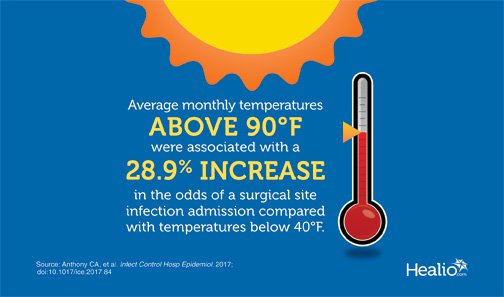SSIs more common in warm weather
The risk for surgical site infection varies by season and is linked with warm weather, according to findings recently published in Infection Control and Hospital Epidemiology.
“At the institutional level, the volume of procedures or institution size may increase the [surgical site infection (SSI)] risk, and other environmental-level risk factors may also exist,” Chris A. Anthony, MD, resident of the department of orthopedic surgery and rehabilitation at the University of Iowa Hospital, and colleagues wrote. “For example, some studies have demonstrated an increased incidence of SSIs for surgeries performed during the summer months. To date, most reports regarding the seasonality of SSIs are based on investigations in single centers, on specific procedures, or in specific geographic regions.”
Anthony and colleagues performed a retrospective cohort study using discharge data from the National Inpatient Sample database. The researchers reviewed all hospital discharges that included a diagnosis of SSI from 1998 to 2011, and used data from the National Climatic Data Center to estimate each month’s average temperature for the locations of all hospitals included in the study.
The incidence of SSIs was “highly seasonal,” Anthony and colleagues reported. Incidence was lowest in January and highest in August, with an average seasonal increase of 2,312 infections from January to August. This increase corresponded to 26.5% (95% CI, 23.3-29.7) more cases in August than in January. After the researchers controlled for hospital-level and demographic characteristics, they estimated that the likelihood of hospital admission for SSI increased by 2.1% per 5°F increase in average monthly temperature.
Average monthly temperatures of hotter than 90°F were associated with a 28.9% (95% CI, 20.2-38.3) increase in the odds of a SSI admission compared with temperatures below 40°F, the researchers wrote.
Anthony and colleagues acknowledged that the study was limited because it did not focus on individual procedures, did not include patient chart reviews and used only inpatient data.
“Despite these limitations, we have demonstrated that the incidence of hospitalizations for SSIs is seasonal and that the seasonality of SSIs can, at least in part, be explained by weather patterns,” the researchers wrote. “Our results suggest that further investigation is needed with more granular data including exact surgery dates and specific procedures. Such work will help determine whether shifting the timing of some surgeries away from peak SSI months can help reduce SSIs in patients with specific procedures.” – by Andy Polhamus
Disclosure: The researchers report no relevant financial disclosures.


